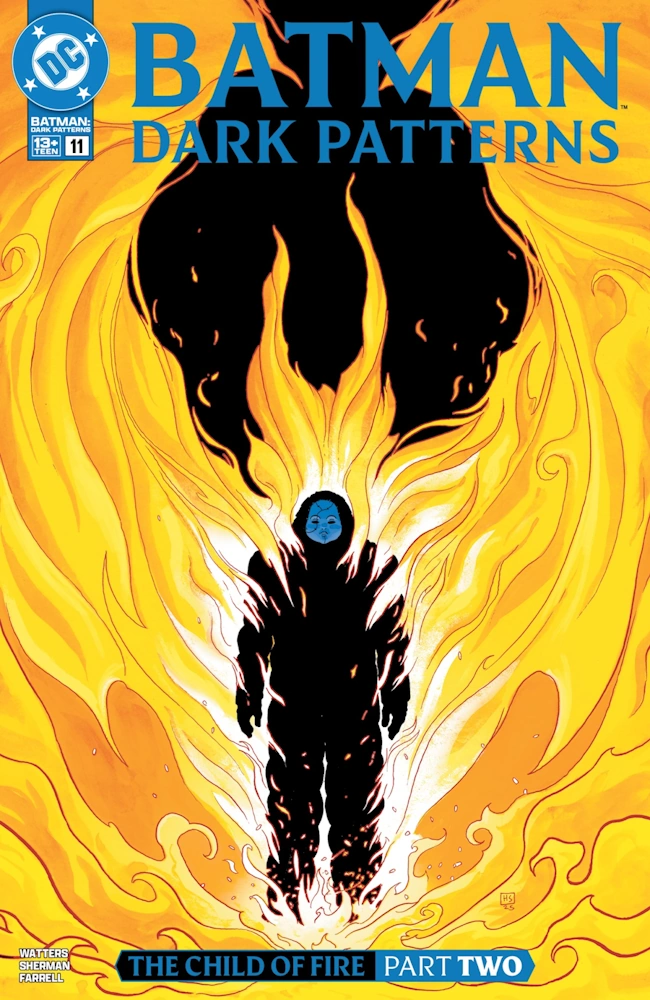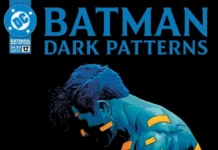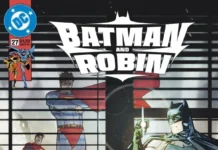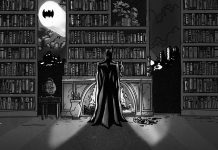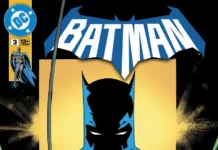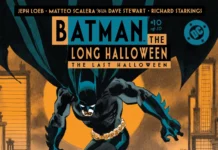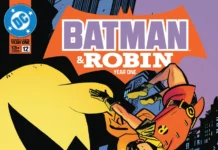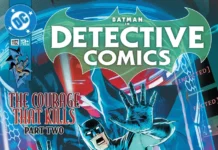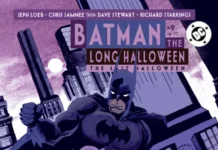The fire rises… literally.
We’re at the penultimate issue of Dark Patterns, and everything is heating up. Bruce Wayne’s fever, Batman’s search for The Child of Fire, and Nicky Harris’s grand plan for the future of Gotham. It all reaches a breaking point in this issue, and I don’t have any idea how it’s all going to end, but I already know it’s going to be great.
I guess we should back up first. The last issue broke the mold a little bit from the previous three arcs, revealing that the titular Child of Fire is none other than”journalist” Nicky Harris. The previous arcs didn’t reveal the real villains until much later, but this approach works here because this arc is bringing the whole book to a close, so there’s more ground to cover. Dr. Sereika, meanwhile, is Batman’s main suspect because he’s gone missing since the first fire of this arc. However, that’s only because he’s been taken prisoner. So a scene with Nicky Harris explaining himself to Dr. Sereika provides some helpful context for what’s happening. The previous issue probably had you thinking that Dr. Sereika was the Child of Fire as well. That’s what Bruce believes when we catch up with him here, and why he’s so consumed with finding him. He believes that he’s been aiding Sereika and has to stop him now.
But if you’ve been reading along, you know that the fires in previous arcs weren’t started by Nicky. At least, that’s not how they were portrayed. The fire that killed the Wound Man’s wife was an accidental house fire that got out of control because no one could feel any pain. The fire at Bledin Towers was started by Michelle under the influence of Scarface. And the fire at the laundromat in the Rookery was started by the old man and two kids to make people think it was the Red Hood gang. Nicky Harris wasn’t present for any of them, at least not in the panels.
But there’s a deeper point to his conversation with Sereika. Harris considers them opposites: he’s a journalist, Sereika’s a forensic pathologist. Journalists tell stories, forensic pathologists look for facts. Harris constructs patterns to lay over the tragedies that plague Gotham, and Sereika aids Batman by looking through those patterns for evidence. In Harris’s mind, these two represent opposite approaches to truth: do we construct truth out of randomized chaos, or do we discern truth by finding it and separating it from narrative? And where does someone like Batman fit in? You might think I’m reading too much into this, but I think this is what the book has been pointing towards. Batman has been firmly committed to truth and not getting distracted by patterns that aren’t there, biases that cloud judgment. Gotham itself has been testing this commitment by throwing all manner of evil at him that seems to demand a larger, more sinister explanation. But the last arc ended with a kid getting shot by accident in a crippled old man’s apartment. Was that the work of powerful forces of evil beyond Batman’s comprehension, or just random tragedy? He clearly feels responsible, which is partly why he’s comatose at the beginning of this arc. But he’s struggling with what kind of evil he’s facing.
So all it takes to turn Batman on Sereika is a story from Nicky Harris involving Sereika, a fire, and a dead student. Who knows how much of that is even true, given Nicky’s agenda. But when Batman thinks the Child of Fire is his partner, Dr. Sereika, he doesn’t even question his conclusions. Which is exactly what he said he wouldn’t do earlier. It shows Batman’s state of mind, but it also shows just how effective Harris has been at manipulating him.
There are some more fantastic scenes here. The dialogue between Bruce and Alfred really stands out, with Alfred getting pretty forceful as his guardian. Their relationship has been mostly in the background to this point, but with Bruce pushing himself more and more, Alfred is understandably challenging him about his mental and physical condition. And you gotta love it when Batman villains get to play the Hannibal Lecter role that Firefly plays in the opening pages. Gordon is clearly desperate for help with Batman tied up in his obsessive search for answers. Also, “You’re a very big, scary Batman, Master Bruce” is a classic Alfred comeback.
No surprise that the art and panel layouts are excellent again, especially when Batman’s silhouette is combined with the Gotham skyline. I won’t say much more because you’ve just really gotta see it. Looking for patterns and signs in the panels and layout is one of the great parts of the experience of reading this book, and there’s only one issue left, so make the most of it. – Trey Jackson

